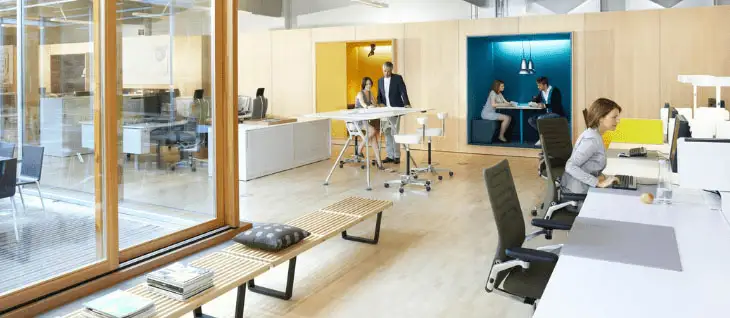With agile working becoming more and more a fact of life, is it any wonder that Head of Remote is tipped to be a trending job title over the next 10 months?
Online job search engine Adzuna, says searches for jobs with opportunities to work at home have risen by 660%, according to Personnel Today.
So as a workplace leader dealing with the changes brought by Covid-19, do you feel that your job is morphing into Head of Remote?
No matter what your industry, if you manage workspace you’ve already been coaxing at least some of your workers through the move to working from home.
Remote working likely to remain part of our lives, partly because people like it and partly because – when done right – it helps companies reduce their carbon footprint, rethink their real estate footprint, and focus on the stress-busting benefits of reducing the daily commute.
But remote working brings its own issues, ranging from loneliness to lack of team-building – so how will you tackle them?
5 key challenges – and their solutions
1. Isolation
2. Physical wellbeing
3. Collaboration and training
4. Teambuilding
5. Reassurance
Isolation – Luke’s story:
“When I first had to work from home, we were in lockdown and my family was there, so loneliness wasn’t an issue – quite the opposite, in fact! But now the kids are back to school, it’s just me and the laptop, and that can seem pretty intense.”
How to help Luke: Set up both formal and informal contact methods with Luke’s line manager – a weekly video call, quick check-in texts and email replies (always get back to him as soon as possible so he doesn’t feel he’s being ignored).
Give Luke some leeway to chat to work friends and colleagues by phone and social media. This is not wasted time – it’s part of the normal social day and a crucial part of enjoying work.
Physical wellbeing – Sarah’s story:
Sarah has a small flat, and has been working on her dressing table.
“My back is killing me, because I’m just perched on the bed,” she says.
How to help Sarah: Every home worker should have a workstation assessment to make sure they have an ergonomically-correct chair and desk or table that protects their physical wellbeing so they can work well.
As a company wanting to avoid compensation claims, investing in suitable equipment makes double sense.
Collaboration and training – Natasha’s story:
Natasha has been promoted to a new job with a new team, but is struggling to get to grips with training.
“It’s so difficult to get up to speed without face-to-face training, and without getting to know my new colleagues so I can ask them as I go along,” she says.
How to help Natasha: Collaboration is the lifeblood of any business – people working together spark ideas, share best practice tips and drive innovation.
Organizations are now well-versed in using collaboration technologies such as Zoom and Teams, but if you want people to make full use of video conferencing, you need to make it easy for them to organize their virtual meetings.
Meeting booking software gives them the ability to book a meeting via an app even across multiple locations and time zones, inviting attendees and informing them automatically of any changes. This also works with hybrid meetings, where some people are in the office and others joining remotely.
Video conferencing does have its limitations, but it’s a good way to integrate new members of the team – everyone likes putting faces to names.
Teambuilding – Saddiq’s story:
This is tricky at the best of times – and particularly so with a remote workforce.
Saddiq says: “I feel I’m drifting away from my friends at work, and I just don’t feel engaged any more.”
How to help Saddiq: The collaboration and training techniques and technologies above can help, but as Head of Remote, you should also set up opportunities for teams to have fun.
You might not be able to go paintballing, but you can hold virtual quizzes and competitions, share successes, send e-cards to say thanks to helpful colleagues and host regular all-hands calls where everyone can post questions to keep the whole team in touch.
Reassurance – Paul’s story:
We all want reassurance in these difficult times…you may be Head of Remote, but one of your priories will still be getting people into the office – safely.
Paul says: “I can’t work from home all the time, and I don’t want to – I’m working on a joint project and sometimes I really need to get together with my team. But I’m wary about going into the office for meetings in case I catch coronavirus.”
How to help Paul: The meeting booking software mentioned earlier also makes it easy for Paul and his colleagues to book co-located desks via their app so they can work safely together.
The app indicates when desks and rooms have been sanitized, and Paul can fill in a pre-attendance health questionnaire before his booking is confirmed. He then gets a QR code so he can check-in and out in a contact-free way.
Visitors and contractors can also use this technology to ensure the workplace remains free of contamination.
Conclusion
The World Economic Forum’s new Future of Work 2020 report warns that Covid-19 has accelerated change in workplaces across the world.
That’s no surprise to anyone caught up in the present crisis – workplace leaders are busy responding to the challenges of the situation and also to the opportunities.
With careful planning, good workplace utilization data and the technology to support agile working, organizations can put themselves in a favourable position not only to come through the present situation – but also to set themselves up for when the whole world begins to recover. It’s a comforting prospect.
Discover more about workplace safely, visitor management and agile working:
